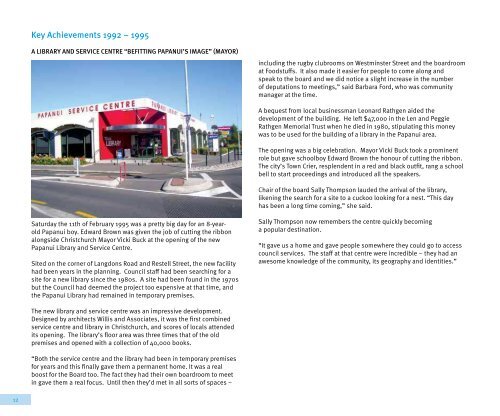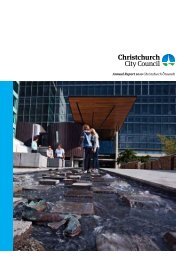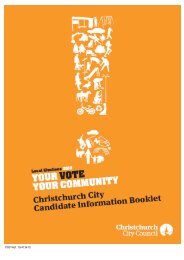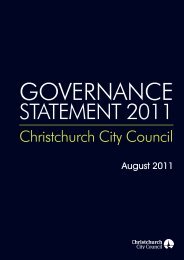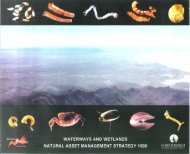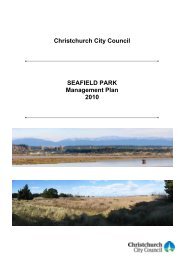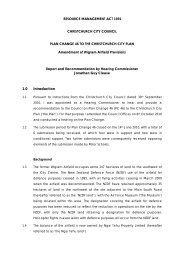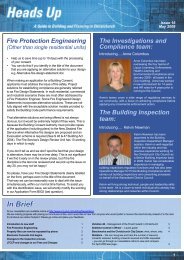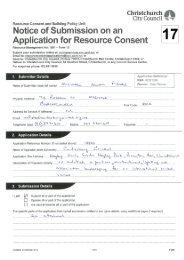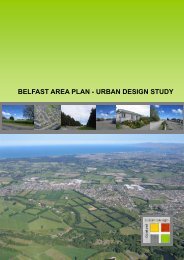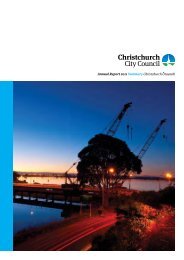Shirley-Papanui Community Board 1989-2010 - Christchurch City ...
Shirley-Papanui Community Board 1989-2010 - Christchurch City ...
Shirley-Papanui Community Board 1989-2010 - Christchurch City ...
You also want an ePaper? Increase the reach of your titles
YUMPU automatically turns print PDFs into web optimized ePapers that Google loves.
Key Achievements 1992 – 1995<br />
A Library And Service Centre “Befitting <strong>Papanui</strong>’s Image” (Mayor)<br />
including the rugby clubrooms on Westminster Street and the boardroom<br />
at Foodstuffs. It also made it easier for people to come along and<br />
speak to the board and we did notice a slight increase in the number<br />
of deputations to meetings,” said Barbara Ford, who was community<br />
manager at the time.<br />
A bequest from local businessman Leonard Rathgen aided the<br />
development of the building. He left $47,000 in the Len and Peggie<br />
Rathgen Memorial Trust when he died in 1980, stipulating this money<br />
was to be used for the building of a library in the <strong>Papanui</strong> area.<br />
Queen Elizabeth II Drive – The Opening Of An Iconic Road<br />
This term also saw the opening of what is still one of <strong>Christchurch</strong>’s<br />
most well-used roads - Queen Elizabeth II Drive, from Main North to<br />
Marshland Roads.<br />
The opening was a major affair with speeches held outside St Bede’s<br />
College and then a convoy of cars testing the road for the first time.<br />
“The community really was excited – it was a huge thing. People knew<br />
we were going to be able to move around the city much more easily,”<br />
remembers Sally Thompson.<br />
Working With Schools<br />
When then Northcote School Principal Graeme Barber approached the<br />
<strong>Community</strong> <strong>Board</strong> in 1994 for funding for a new playground, the <strong>Board</strong><br />
came up with an innovative solution – they would grant funding provided<br />
the whole community could have access to the space.<br />
This was the beginning of a move towards “boundary-less” schools –<br />
the idea that schools were a community asset that should be open to<br />
the public once classes were over. The idea was popular not only with<br />
the Council, as it meant greater recreational space for its constituents,<br />
but with the schools themselves.<br />
Saturday the 11th of February 1995 was a pretty big day for an 8-yearold<br />
<strong>Papanui</strong> boy. Edward Brown was given the job of cutting the ribbon<br />
alongside <strong>Christchurch</strong> Mayor Vicki Buck at the opening of the new<br />
<strong>Papanui</strong> Library and Service Centre.<br />
Sited on the corner of Langdons Road and Restell Street, the new facility<br />
had been years in the planning. Council staff had been searching for a<br />
site for a new library since the 1980s. A site had been found in the 1970s<br />
but the Council had deemed the project too expensive at that time, and<br />
the <strong>Papanui</strong> Library had remained in temporary premises.<br />
The new library and service centre was an impressive development.<br />
Designed by architects Willis and Associates, it was the first combined<br />
service centre and library in <strong>Christchurch</strong>, and scores of locals attended<br />
its opening. The library’s floor area was three times that of the old<br />
premises and opened with a collection of 40,000 books.<br />
The opening was a big celebration. Mayor Vicki Buck took a prominent<br />
role but gave schoolboy Edward Brown the honour of cutting the ribbon.<br />
The city’s Town Crier, resplendent in a red and black outfit, rang a school<br />
bell to start proceedings and introduced all the speakers.<br />
Chair of the board Sally Thompson lauded the arrival of the library,<br />
likening the search for a site to a cuckoo looking for a nest. “This day<br />
has been a long time coming,” she said.<br />
Sally Thompson now remembers the centre quickly becoming<br />
a popular destination.<br />
“It gave us a home and gave people somewhere they could go to access<br />
council services. The staff at that centre were incredible – they had an<br />
awesome knowledge of the community, its geography and identities.”<br />
“There was some confusion from the public over some politicians’<br />
support for the road. People couldn’t understand why we were so in<br />
favour of this project when we had fought the northern arterial. But this<br />
was different – it was built on farmland, no one lost their home and no<br />
suburb was split in two,” said Sally Thompson.<br />
“I remember it became a well-used road almost immediately. The next<br />
morning it was flooded with cars and I remember thinking “Wow – there<br />
was clearly a need for that road,” said Yvonne Palmer, board member.<br />
“The goal was a seamless connection between the school and the<br />
community, and from our point of view it was win-win,” said Barber.<br />
“The school would get natural surveillance, and the community would<br />
get the use of facilities.”<br />
It was also the start of a long and mutually beneficial relationship<br />
between the <strong>Board</strong>, Northcote School, and the wider community, which<br />
saw an access way being funded by the <strong>Board</strong> so the public could get to<br />
Redwood Park from Tuckers Road without tramping on the ‘sometimes<br />
muddy’ school fields.<br />
Soon, other school principals were following the lead – coming to<br />
meetings and sharing problems and developing solutions together. This<br />
resulted in many community projects, including a new cycle way into<br />
<strong>Shirley</strong> Intermediate.<br />
“The community development approach of the <strong>Board</strong> was really good,”<br />
said Barber. “There was an emphasis on looking at family and community<br />
well-being as opposed to just building things.”<br />
Work between the <strong>Community</strong> <strong>Board</strong> and St Albans and Paparoa Street<br />
Schools also saw them leave their gates open and that had an excellent<br />
side effect - a drop in vandalism.<br />
“Both the service centre and the library had been in temporary premises<br />
for years and this finally gave them a permanent home. It was a real<br />
boost for the <strong>Board</strong> too. The fact they had their own boardroom to meet<br />
in gave them a real focus. Until then they’d met in all sorts of spaces –<br />
12 13


